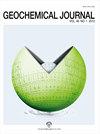用电感耦合等离子体质谱分析球粒陨石基质中单个粒子的元素和同位素特征
IF 1.6
4区 地球科学
Q3 GEOCHEMISTRY & GEOPHYSICS
引用次数: 0
摘要
采用电感耦合等离子体飞行时间质谱仪(ICP-TOF-MS)和配备高时间分辨率离子计数器(HTR-MC-ICP-MS)的多重收集器- icp - ms对球粒陨石基体中亚微米大小的单个颗粒进行了元素和同位素分析。通过激光液相烧蚀(LAL)技术从Allende CV3球粒陨石中收集颗粒。首先,测定了6086个颗粒中Si、Al、Mg、Fe四种主要元素的丰度,表明Allende基体是亚微米级颗粒的混合物,主要由橄榄石、辉石、尖晶石、Fe - ni硫化物和Fe - ni金属组成,与星云凝聚模型预测的主要组成矿物相一致。主要元素组成表明,Fe-Ni颗粒是Allende基体中的次要成分(约占数量分数的0.3%)。然后,为了估计这些金属颗粒的来源,测量了Ni和两种次要元素(Os和Pt)的丰度。在球粒陨石基体中还发现了10417个含Ni-Os-Pt颗粒。大部分颗粒富集镍元素。Os和Pt以分离的粒子形式存在,没有发现同时存在Os和Pt的粒子。最后,利用HTR-MC-ICP-MS技术测定了1545个粒子的195Pt/194Pt值。得到的195Pt/194Pt值与太阳成分在分析不确定度范围内一致。195Pt/194Pt同位素异常的缺乏可以解释为大多数铂块来自太阳系的均匀储层,或者是在太阳星云形成之前铂的同位素均质化。本文章由计算机程序翻译,如有差异,请以英文原文为准。
Elemental and Isotopic Signatures of Individual Particles in Chondrite Matrix using Inductively Coupled Plasma Mass Spectrometry
Elemental and isotopic analyses of individual submicron-sized particles in chondrite matrix were made by an inductively coupled plasma time-of-flight mass spectrometer (ICP-TOF-MS) and a multiple collector-ICP-MS equipped with high-time resolution ion counters (HTR-MC-ICP-MS). The particles were collected from Allende CV3 chondrite through a laser ablation-in-liquid (LAL) technique. Firstly, the abundances for four major elements (Si, Al, Mg, and Fe) were determined on total 6086 particles, indicating that the Allende matrix is a mixture of submicron-sized particles made mainly of olivine, pyroxene, spinel, Fe–Ni sulfide and Fe–Ni metal, consistent with the predicted major constituent minerals by nebular condensation model. The major elemental compositions revealed that Fe–Ni particles are minor components (about 0.3% in number fraction) in the Allende matrix. Then, to estimate the origin of these metallic particles, abundances for Ni and two minor elements (Os and Pt) were measured. Total 10417 particles of Ni–Os–Pt bearing particles were also found in the chondrite matrix. Majority of the particles were enriched in Ni. Os and Pt were present as separated particles, and no particles with presence of both the Os and Pt were found. Finally, with the HTR-MC-ICP-MS technique, 195Pt/194Pt value was measured on total 1545 particles. The resulting 195Pt/194Pt value agreed with the solar composition within analytical uncertainties. This lack in isotopic anomalies of the 195Pt/194Pt can be explained either by majority of the Pt nuggets being produced from uniform reservoir in the solar system or by Pt being isotopically homogenized prior to the formation of the solar nebula.
求助全文
通过发布文献求助,成功后即可免费获取论文全文。
去求助
来源期刊

Geochemical Journal
地学-地球化学与地球物理
CiteScore
1.70
自引率
12.50%
发文量
11
审稿时长
6 months
期刊介绍:
Geochemical Journal is an international journal devoted to original research papers in geochemistry and cosmochemistry. It is the primary journal of the Geochemical Society of Japan. Areas of research are as follows:
Cosmochemistry; Mineral and Rock Chemistry; Volcanology and Hydrothermal Chemistry; Isotope Geochemistry and Geochronology; Atmospheric Chemistry; Hydro- and Marine Chemistry; Organic Geochemistry; Environmental Chemistry.
 求助内容:
求助内容: 应助结果提醒方式:
应助结果提醒方式:


